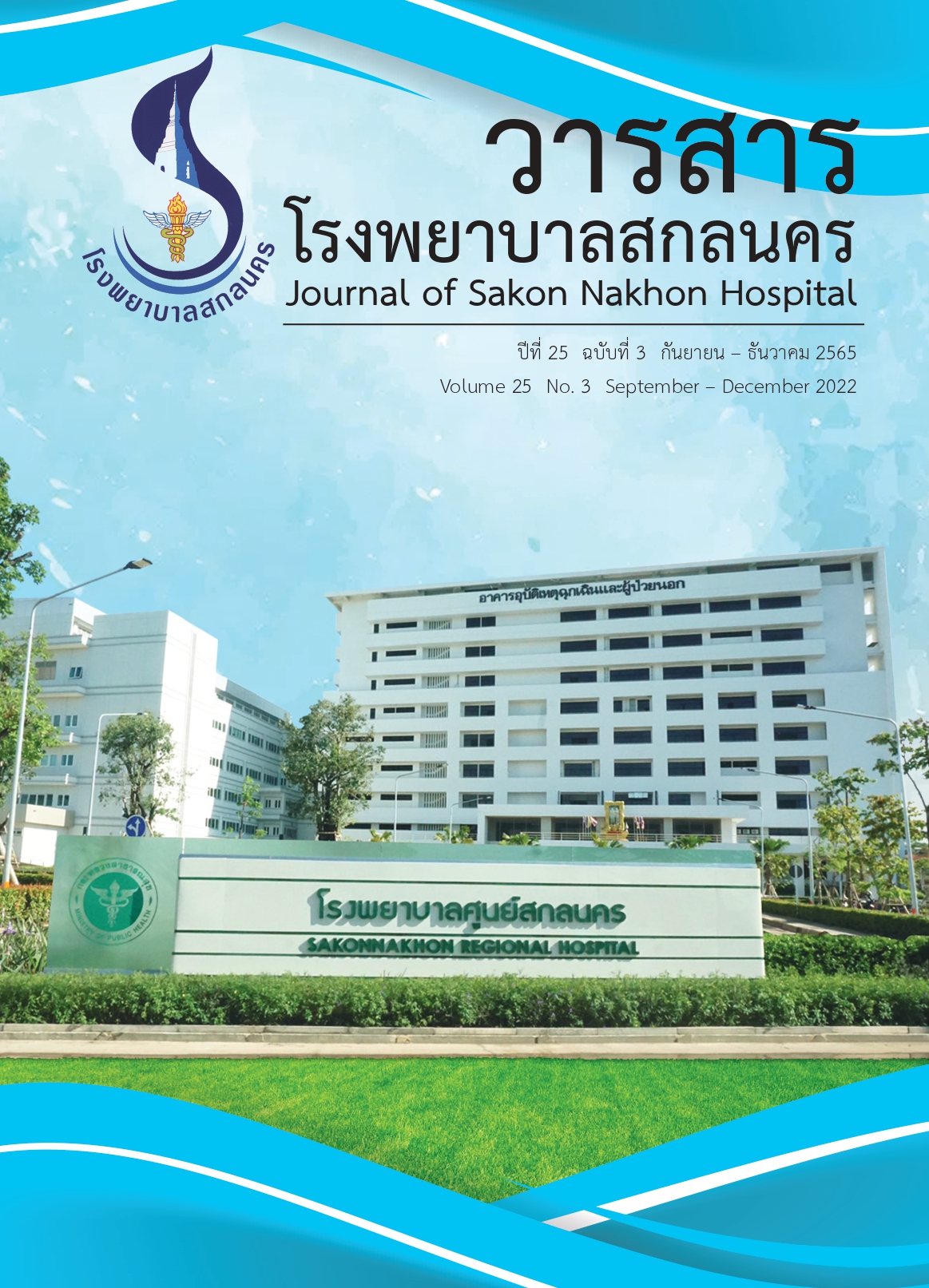A Study of Conscious Sedation with Ketamine–Propofol for Closed Reduction in Closed Fracture Forearm and Leg
Keywords:
Ketamine, Propofol, Conscious sedation, Closed reductionAbstract
The objective of this study was to evaluate the effectiveness of conscious sedation with Ketamine–Propofol for closed reduction in 90 patients aged 3 – 70 years who presented with closed fracture forearm and leg, and required sedation for closed reduction by Orthopedists at operating room, Sakon Nakhon hospital. They were received 1 microgram/kilogram of Fentanyl, 0.5 milligram/ kilogram of Ketamine and 1 milligram/kilogram of Propofol. The time intervals were measured from drug administration to reduction, awake, recovery and fulfill the criteria for discharge from a recovery room.
The results showed that the closed reduction was successfully performed in 90 patients (100%). The average time intervals from drug administration to reduction, awake and first purposeful response and to safety discharge from recovery room were 3, 11.14 and 31.67 minutes, respectively. Patients were breathing spontaneously during the maneuver without any complication. Moreover, they were easy to awake and had adequate ventilation, fast recovery, no pain and no hemodynamic change. The only complication, which is nausea/vomiting, was found in 3 patients (3.33%) and could be treated by medication without repeated symptom.
In conclusion, conscious sedation with Ketamine together with Propofol is efficient and effective for patients who underwent closed reduction in closed fracture forearm and leg in terms of safety and fast recovery.
References
Armornyotin S. Anesthesia Innovations for Endoscopy of Gastrointestinal Tract. In: Amornyotin S, editors. Endoscopy–Innovative Uses and Emerging Technologies; 2015. p. 39–61
Amornyotin S. Sedation and monitoring for gastrointestinal endoscopy. World J Gastrointest Endosc 2013;5(2):47–55.
Amornyotin S. Sedative and analgesic drugs for gastrointestinal endoscopic procedure. J Gas troenterol Hepatol Res 2014;3(7):1133–44.
คณะอนุกรรมการพัฒนาบัญชียาหลักแห่งชาติและคณะทำงานผู้เชี่ยวชาญแห่งชาติด้านการคัดเลือกยาสาขาวิสัญญีวิทยา และการระงับการปวด. General anesthetics: Anticholinesterases and antimuscarinic druge Used in anesthesia. ใน: วรสุดา ยูงทอง, อัญชลี จิตรักนที, วรรณนิษา เถียรทวี, นิพัทธ์ สุขแสนสำราญ, จุฑาทิพ เลาหเรืองชัยยศ, ธนิศา ทาทอง, และคนอื่นๆ, บรรณาธิการ. คู่มือการใช้ยาอย่างสมเหตุสมผล ตามบัญชียาหลักแห่งชาติ ยาที่ใช้ทางวิสัญญีวิทยาและการระงับปวด Thai
National Formulary 2015 of Anesthetics and Pain Medication. กรุงเทพฯ: กลุ่มนโยบายแห่งชาติด้านยา สำนักยา สำนักงาน คณะกรรมการอาหารและยา; 2560. หน้า 37.
คณะอนุกรรมการพัฒนาบัญชียาหลักแห่งชาติและคณะทำงานผู้เชี่ยวชาญแห่งชาติด้านการคัดเลือกยาสาขาวิสัญญีวิทยา และการระงับการปวด. General anesthetics: Muscle relaxants (Neuromuscular Blocking drugs. ใน: วรสุดา ยูงทอง, อัญชลี จิตรักนที, วรรณนิษา เถียรทวี, นิพัทธ์ สุขแสนสำราญ, จุฑาทิพ เลาหเรืองชัยยศ, ธนิศา ทาทอง, และคนอื่นๆ, บรรณาธิการ. คู่มือการใช้ยาอย่างสมเหตุสมผล ตามบัญชียาหลักแห่งชาติ ยาที่ใช้ทางวิสัญญีวิทยาและการระงับปวด Thai National Formulary 2015 of Anesthetics and Pain Medication. กรุงเทพฯ: กลุ่มนโยบายแห่งชาติด้านยา สำนักยา สำนักงานคณะกรรมการอาหารและยา; 2560. หน้า 13.
Amornyotin S. Ketofol: a combination of ketamine and propofol. Journal of Anesthesia & Critical Care: Open Access 2014;1(5):00031.
Willman EV, Andolfatto G. A prospective evaluation of “ketofol” (ketamine/propofol combination) for procedural sedation and analgesia in the emergency department. Ann Emerg Med 2007;49(1):23–30.
Fiset P, Paus T, Daloze T, Plourde G, Meuret P, Bonhomme V, et al. Brain mechanisms of propofol–induced loss of consciousness in humans: a positron emission tomographic study. J Neurosci 1999;19(13):5506–13.
Gupta A, Steirer T, Zuckerman R, Sakima N, Parker SD, Fleisher LA. Comparison of recovery profile after ambulatory anesthesia with propofol, isoflurane, sevoflurane and desflurane: a systemic review. Anesth Analg 2004;98(3):632–41.
Amornyotin S, Suraseranivongse S, Muangman S, Sattawathamrong Y, Tensit K, Prakotsue K, et al. Comparison of dose requirement of diluted and undiluted propofol for patients undergoing ERCP. Thai J Anesthesiol 2003;29(1):6–12
Sharieff GQ, Trocinski DR, Kanegaye JT, Fiser B, Harley JR. Ketamine–Propofol Combination Sedation for Fracture Reduction in the Pediatric Emergency Department. Pediatric Emergency Care 2007;23(12):881–4.
McKenna P, Leonard M, Connolly P, Boran S, McCormack D. A Comparison of Pediatric Forearm Fracture Reduction Between Conscious Sedation and General Anesthesia. Orthop Trauma 2012;26(9):550–5.
Chan MK, Cawthorne DP, St George JE, Little DG. Closed reduction of paediatric forearm fracutres: nitrous oxide versus general anaesthetic. ANZ J Surg 2020;90(11):2232–2236.
Daniel WW. Biostatistics: A foundation of analysis in the health sciences. 6th ed. New York: Wiley & Sons; 1995.
Maurer WG, Walsh M, Viazis N. Basic requirements for monitoring sedated patients: blood pressure, pulse oximetry, and EKG. Digestion 2010;82(2):87–9.
Charuluxananan S, Saengchote W, Klanarong S, Punjasawadwong Y, Chau–in W, Lawthaweesawat C, et al. Quality and patient safety in anesthesia service: Thai survey. Asian Biomed 2010;4(3):395–401.
Charuluxananan S, Roadanant O, Charoenraj P, Somboonviboon W, kyokong O. Survey of knowledge and opinions concerning qulaity in anesthesia service among Thai anesthesia personnel. Thai J Anesthesiol 2002;28:225–35.
American Society of Anesthesiologists Task Force on Sedation and Analgesia by Non–Anesthesiologists. Practice guidelines for sedation and analgesia by non–anesthesiologists. Anesthesiology 2002;96(4):1004–17.
Chernik DA, Gllings D, Laine H, Hendler J, Silver JM, Davidson AB, et al. Validity and reliability of the observer’s Assessment of Alertness/Sedation scale: study with intravenous midazolam. J Clin Psychopharmacol 1991;10(4):244–51.
Aldrete JA. The Postanesthesia recovery score revisited. J Clin Anesth 1995;7(1):89–91.
Chung F. Are discharge criteria changing?. J Clin Anesth 1993;5(6 Suppl 1):64S–68S.
Downloads
Published
How to Cite
Issue
Section
License
บทความที่ตีพิมพ์ถือว่าเป็นลิขสิทธิ์ของวารสารโรงพยาบาลสกลนคร การคัดลอกเพื่อพัฒนาเชิงวิชาการต้องได้รับการอ้างอิงอย่างถูกต้อง






